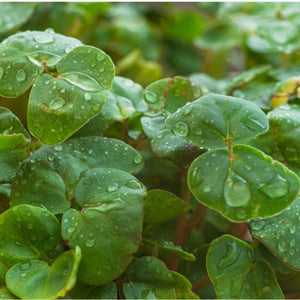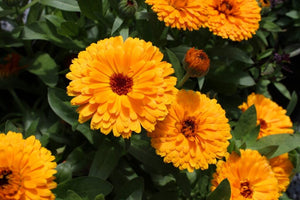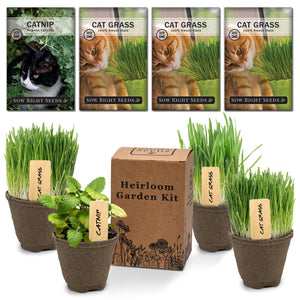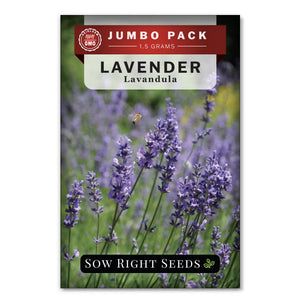Topics
How to Get Started Growing Lavender - Lavender Garden Kit
Growing guidesIf you're looking to add some beauty and relaxation to your home, consider growing lavender in planters. Our Lavender Garden Kit provides everything you need to get started, from seeds to soil. Not only does lavender offer a calming fragrance, but it also has numerous health benefits and can be used in herbal teas and home remedies. Discover the endless possibilities of growing lavender in your own home.

When you have fresh Lavender readily available, the possibilities are endless. You can make lavender oil, put lavender in your teas, add it to your dinner delicacies, craft it into lovely dried arrangements, or simply love the purple flowers that you'll see throughout your garden.
Our Lavender Growing Kit is exactly what you need to get your Lavender garden flourishing for on-hand herbal teas, remedies, and cooking. There are so many ways to use the flowers and leaves that you don't want to be without lavender when you need it the most.
So Many Uses for Lavender
Lavender oil made by crushing the buds, blooms, and leaves can be added to diffusers to help with sinus congestion and headaches. The oil can also be applied to nerve points to aid anxieties and nerves.
Cutting Lavender stalks to dry for tea is one of the most wonderful uses of this herb. Lavender teas can be used to alleviate stomach cramps and soothe anxieties.
Dried Lavender, or the oils, can also be used in lotions, ointments, and crèmes for a lovely calming element. Simply the smell of Lavender is so dreamy you may even enjoy it in your daily soap!
Using the perennial plant to line paths and walkways gives a pop of color and a finished look to any landscape. Many also like to include lavender in their flower beds to attract pollinators!
Lavender plants, especially in the compostable pots in our kit, make a wonderful gift to friends and family alike!

Growing lavender from seed:
- Start by following the instructions for hydrating the soil discs.
- Once the soil is expanded and in pots, you are ready to start planting.
- Plant the seeds according to the instructions on the seed packet in each pot.
Knowing how and when to water is vital:
- Water by misting until the seeds start to sprout.
- Take care that the seeds don’t dry out too quickly – seeds need to stay moist but not waterlogged to sprout.
- Once the seedlings are growing, less frequent but more deep watering will encourage root growth.
- The pot should not dry out completely between waterings, just the top layer of soil. If the pot is dry deeper than the top 1 inch, then it’s time to water.
Now that you’ve got the watering down, you’ll want to consider the other thing that plants need – food. The soil that comes in your kit has the added amendments that create a fertile growing environment. If you transplant to a garden or larger pots, you may need to add fertilizer. Most herbs don’t need a lot of fertilizer, but they do benefit from nitrogen for leaf growth. Adding organic matter (compost and/or leaves) to your garden beds before transplanting can help supplement the additional nutrients that your plants will need as they grow. The included pots can easily be planted directly into the garden if you’d like to grow outdoors instead. When soil and outside temperatures are above 60 degrees, follow the directions on transplanting the biodegradable pots.
Grow Lavender in any type of garden!
If you have an herb garden, the Lavender plants will fit in next to your Echinacea, oregano, or basil. Plant lavender in your flower garden with other varieties that like full sun. Next to your tomatoes, onions, or lettuce, lavender can help detract pests.
Growing Lavender Indoors
If you would prefer to keep your herbs inside so that you can easily access them, here’s some extra pieces of info you might find helpful for growing lavender indoors.
- Place the pots on trays or saucers to protect surfaces.
- To increase indoor humidity in the winter months, place the pots on a tray of pebbles with water.
- You’ll need a sunny window location – a south or southwest-facing window will usually give the 6 to 8 hours of daily sunlight needed for herbs to grow.
- A pair of sharp kitchen shears is a helpful tool for herb harvesting and pruning.
Lavender Tips & Tricks
- Be careful not to overwater, as this can cause root rot. Lavender needs well-drained soil, so make sure the soil is dry before watering the next time.
- Instead of using a mulch that retains water, use pea gravel around your lavender plants to help keep the water drained from the soil.
- When transplanting, make sure not to cover up the base or crown of the seedling with lots of soil. This could cause the plant to get too wet and rot.
- Lavender can grow to be three feet tall! This means that pruning the plants regularly is the best practice in order to keep each plant tamed but also to keep the plants producing.
- Don't skimp on the light. Lavender is a plant that needs all the sunlight it can get. This usually means about 6 to 8 hours of full sunlight a day.
- Be careful not to harvest too much at one time. The plants will not be ready for harvest until about a year after planting. Once the plants are ready to harvest, only about a third of the plant should be taken to allow the rest of the plant to continue growing without struggle.
Have more growing questions? At Sow Right Seeds, we love gardening, and we want your experience to be successful. Explore our Planter's Library for more helpful growing information. And check out our selection of herb, flower, and vegetable varieties to see what you’d like to grow next!










Leave a comment